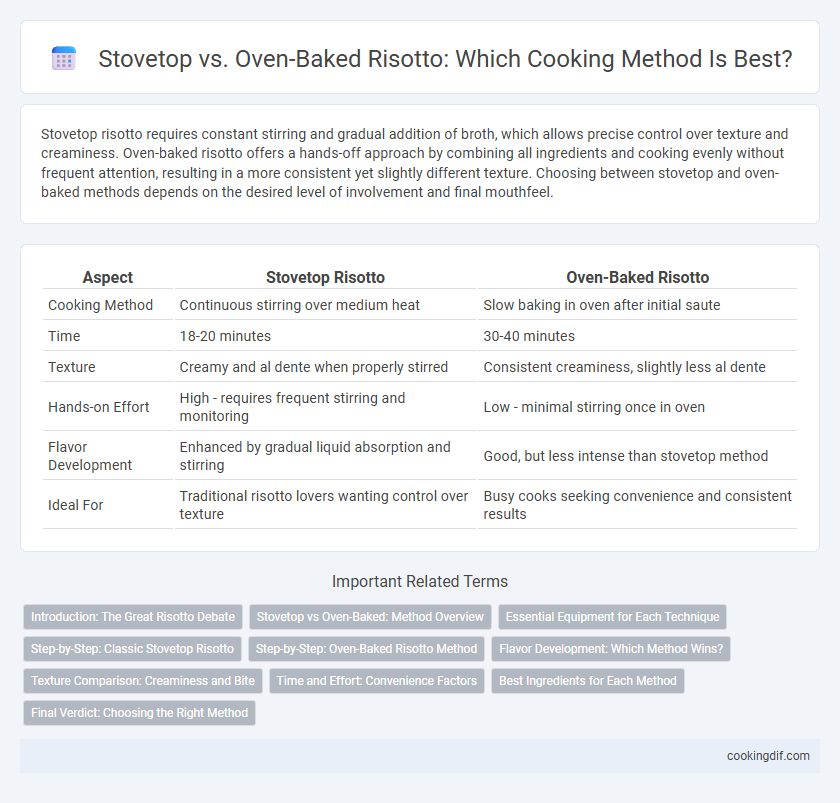Stovetop risotto requires constant stirring and gradual addition of broth, which allows precise control over texture and creaminess. Oven-baked risotto offers a hands-off approach by combining all ingredients and cooking evenly without frequent attention, resulting in a more consistent yet slightly different texture. Choosing between stovetop and oven-baked methods depends on the desired level of involvement and final mouthfeel.
Table of Comparison
| Aspect | Stovetop Risotto | Oven-Baked Risotto |
|---|---|---|
| Cooking Method | Continuous stirring over medium heat | Slow baking in oven after initial saute |
| Time | 18-20 minutes | 30-40 minutes |
| Texture | Creamy and al dente when properly stirred | Consistent creaminess, slightly less al dente |
| Hands-on Effort | High - requires frequent stirring and monitoring | Low - minimal stirring once in oven |
| Flavor Development | Enhanced by gradual liquid absorption and stirring | Good, but less intense than stovetop method |
| Ideal For | Traditional risotto lovers wanting control over texture | Busy cooks seeking convenience and consistent results |
Introduction: The Great Risotto Debate
Stovetop risotto requires constant stirring and gradual addition of broth, ensuring a creamy texture and precise control over consistency. Oven-baked risotto offers a hands-off approach by combining ingredients and cooking evenly in the oven, producing a rich flavor with less effort. Both methods yield authentic risotto, but stovetop remains the traditional choice for culinary purists seeking a perfectly al dente bite.
Stovetop vs Oven-Baked: Method Overview
Stovetop risotto requires constant stirring and gradual addition of broth to achieve a creamy texture, allowing precise control over cooking. Oven-baked risotto simplifies the process by combining all ingredients in a single dish and baking at a consistent temperature, reducing hands-on time. Both methods yield flavorful results, but stovetop risotto tends to have a more traditional, creamy consistency, whereas oven-baked risotto offers convenience and even cooking.
Essential Equipment for Each Technique
Stovetop risotto requires essential equipment such as a heavy-bottomed saute pan or skillet, a wooden spoon for constant stirring, and a ladle to gradually add warm broth. Oven-baked risotto needs an oven-safe baking dish or Dutch oven with a secure lid to ensure even cooking and consistent heat distribution. Both techniques benefit from having a heatproof spatula and a fine-mesh strainer to prepare ingredients like broth and vegetables efficiently.
Step-by-Step: Classic Stovetop Risotto
Classic stovetop risotto requires gradually adding warm broth to Arborio rice while stirring constantly to release the starches that create its creamy texture. Start by sauteing onions and garlic in olive oil or butter, then toast the rice briefly before adding broth one ladle at a time, allowing each to absorb fully before the next. This method demands attention and patience but results in a rich, velvety risotto with perfectly tender grains.
Step-by-Step: Oven-Baked Risotto Method
Oven-baked risotto offers a hands-off approach, starting with sauteing onions and rice in a hot ovenproof pan before adding warm broth and baking at 375degF for about 25-30 minutes. This method ensures even cooking and creamy texture while reducing constant stirring compared to stovetop risotto. The final step involves stirring in butter and Parmesan cheese to enrich the flavor and achieve the classic silky consistency.
Flavor Development: Which Method Wins?
Stovetop risotto guarantees superior flavor development by allowing precise control over gradual liquid absorption and continuous stirring, which promotes the release of starches for a creamy texture and deeper taste. Oven-baked risotto offers convenience and consistency but often lacks the nuanced caramelization and complex flavors achieved through the traditional stovetop method. Flavor enthusiasts typically prefer stovetop risotto for its rich, layered taste profiles crafted through attentive cooking techniques.
Texture Comparison: Creaminess and Bite
Stovetop risotto delivers a creamier texture through constant stirring and gradual liquid absorption, allowing the rice to release more starch. Oven-baked risotto offers a more uniform bite with a slightly firmer grain, achieved by baking the mixture evenly without frequent agitation. Textural preferences vary, with stovetop risotto prized for its luscious creaminess and oven-baked risotto favored for a consistent, tender firmness.
Time and Effort: Convenience Factors
Stovetop risotto requires constant stirring and attention, typically taking 20-30 minutes, making it labor-intensive but allowing precise control over texture. Oven-baked risotto offers a hands-off approach, cooking evenly in about 45 minutes, reducing active effort and freeing time for multitasking. Choosing between methods depends on balancing desired texture control with convenience and available time.
Best Ingredients for Each Method
Stovetop risotto thrives with arborio or carnaroli rice, fresh broth, and frequent stirring to achieve a creamy texture, complemented by quality butter, Parmesan, and aromatic ingredients like shallots and white wine. Oven-baked risotto benefits from heartier ingredients such as mushrooms, sausage, or root vegetables, which can slow-cook evenly, while using broth, rice like arborio, and less frequent stirring allows the oven's consistent heat to infuse flavors uniformly. Both methods demand high-quality broth and fresh ingredients, but stovetop excels with delicate, quick-cooking add-ins, whereas oven-baked suits robust, slow-cooking components that meld over extended heat.
Final Verdict: Choosing the Right Method
Stovetop risotto offers precise control over texture and flavor development through constant stirring and gradual liquid addition, resulting in a creamy, al dente dish. Oven-baked risotto provides convenience and consistent cooking by allowing even heat distribution, ideal for hands-off preparation and larger batches. Choose stovetop for traditional, customizable results and oven-baked for easy, set-it-and-forget-it meals without sacrificing quality.
Stovetop vs Oven-baked for method Infographic

 cookingdif.com
cookingdif.com